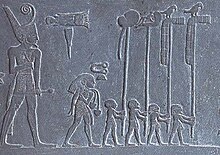Vexilloid

A vexilloid is any flag-like (vexillary) object used by countries, organisations, or individuals as a form of representation other than
An object which functions as a flag but differs from it in some respect, usually appearance. Vexilloids are characteristic of traditional societies and often consist of a staff with an emblem, such as a carved animal, at the top.
This includes

The use of flags replaced the use of vexilloids for general purposes during late
History
Vexilloids originally started as a staff of office for leaders of groups, such as tribes, and were also used as a visible sign to rally around or point to a direction of attack. They were originally made of wood, horns, tails, hooves, and skins of animals, with other ornaments being made of carved and painted wood or metal. Aztec vexilloids composed of green quetzal feathers, metals such as gold, and precious stones. Modern vexilloids used by tribes of New Guinea are made of wood, dried grass and feathers, and emblems painted on wood, feathers, and cloth.[3]

The oldest known vexilloids appear as depictions on Egyptian pottery from the

Ancient Greek armies used a vexillum-like banners, such as the so-called phoinikis, a cloth of deep red, suspended from the top of a staff or spear. It is not known to have carried any device or decoration though.
Ancient Romans adopted the use of vexilloids, as well as their eagle emblem, from the Persians. The standards of Roman legions consisted of a lance with a silver-plated shaft, topped with a crosspiece carrying figures of various beasts, the most important being the eagle. Attached to the shaft were several metal rings which took the form of laurel wreaths and medallions with images of gods, the Emperor, and members of the Imperial House.[3]
Ancient Mongolians also used vexilloids in the form of a staff topped with a metal ball or spearhead, with a horse's tail attached to it. This vexilloid, called a tug, spread among Turkish people and became military symbols in Turkish forces. In the 17th and 18th centuries they were carried before commanders-in-chief of the Polish Army.[3]
Examples
Ancient

- The Achaemenid Empire used a stylised falcon on its vexilloid.
- The vexilloid of Macedonian Empire displayed the Vergina Sun.
- The Greco-Bactrian Kingdom has an Elephant as their symbol.
- The Indo-Greek Kingdom has The Buddhist Triratna as their symbol.
- The Indo-Scythians has a Lion or a Leopard standing right as their symbol.
- The vexilloid of The Indo-Parthian Kingdom is likely pretty similar to The Parthian Sun and it is related with The Derafsh Kaviani.
- The vexilloid of The Kushan Empire is suspended on the point of a Spear or Trident
- The symbol of the Mauryan Empire was the Ashoka Chakra.
- The Gupta Empire has The Garuda as their symbol.
- The vexilloid of Ancient Carthage most probably consisted of a spear with a disk and crescent (points upwards), symbolising the god Baal (sun = disk) and the goddess Tanit (moon = crescent).[4]
- The Ptolemaic Kingdom has The Eagle of Zeus as their symbol.
- The vexillum of Ancient Rome displayed the slogan S·P·Q·R (senātus populusque Rōmānus), "The Roman Senate and People", in gold on a field of crimson.
- The Sassanian Empire, which is called Eran Shahr (Aryan Empire) in Middle Persian,[5] used lotus symbol on its vexilloid, which is called the Derafsh Kaviani.[6][7]

Medieval
- The tugh of Central Asian and Turkic peoples of the pre-Ottomanand Ottoman periods.
- The vexilloid of the off-blackinstead of off-white as they were cut from black instead of white horses.
- Heraldic flags are forms of vexilloids with designs based on heraldry, a famous example being the Oriflamme of France.
- The Chola empire had the tigeras their symbol and flag.
Modern
- The French Imperial Eagle was a figure of an eagle on a staff carried into battle by the Grande Armée of Napoleon during the Napoleonic Wars.
- In SS used vexilloids which they marched with in street parades and at the Nuremberg rallies. These vexilloids were topped with an eagle and a swastika and with the name of the particular locale of the SS contingent carrying the vexilloids. Inscribed on them was the slogan Deutschland Erwache, which means Germany Awake.[8][9]
Sources
- ISBN 0-07-059093-1.
References
- ^ Vexilloids, Flags of the World, archived from the original on Apr 4, 2023.
- ^ OCLC 1324552.
- ^ ISBN 978-1-4351-1838-6.
- ^ Vexilloid of the Carthaginian Empire:
- Wiesehofer, JosephAncient Persia New York:1996 I.B. Tauris
- ^ Website honoring Dr. Kourosh Aryamanesh—Depicts images of the Derafsh Kaviani:
- ^ Image of the Derafsh Kaviani:
- ^ Hitler and the Rise of Nazism (Museum of World War II – Navick, Massachusetts, USA): Archived May 29, 2010, at the Wayback Machine
- ^ Image of an SS vexilloid: Archived December 18, 2010, at the Wayback Machine
